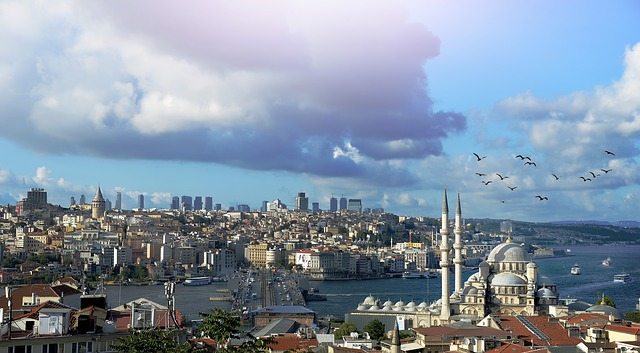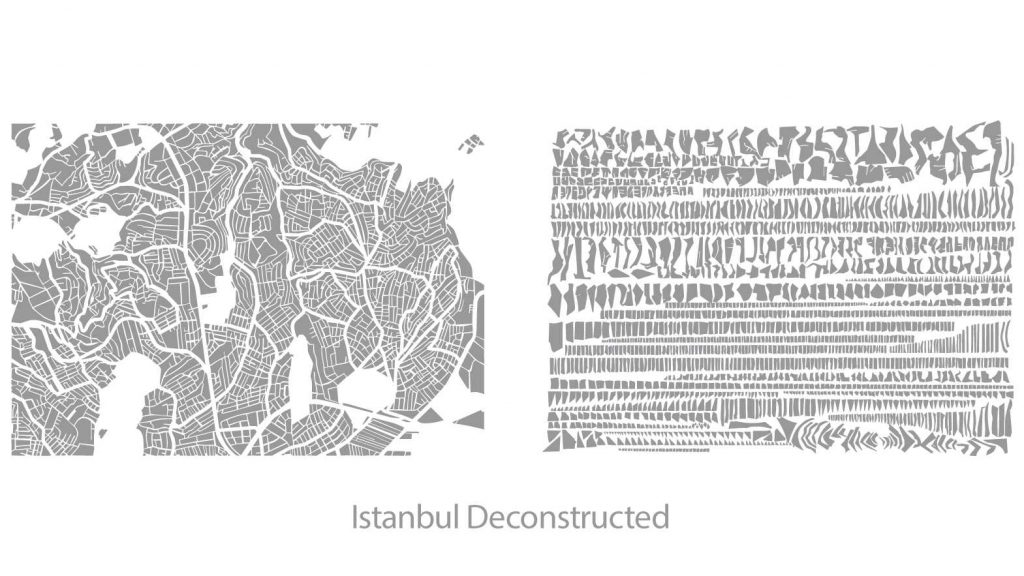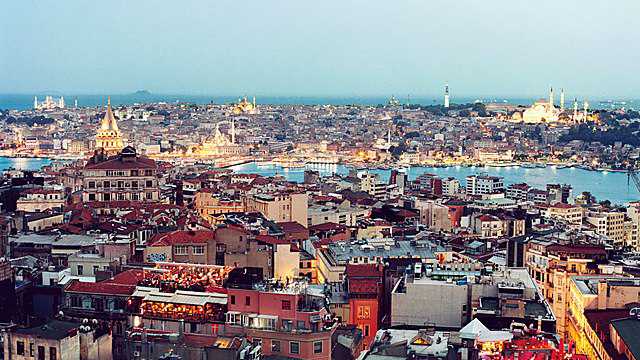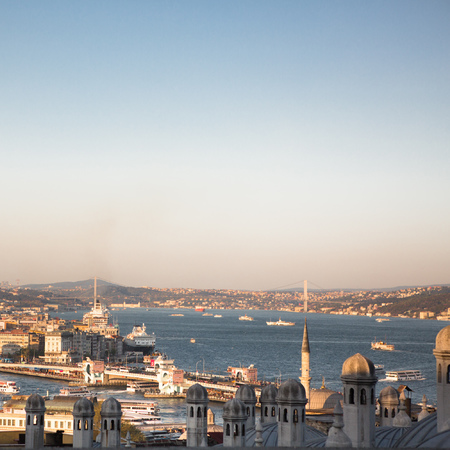If you know where to look, Istanbul’s Roman past pokes up throughout the city, as Harry Mount discovers.
By Harry Mount
Exactly 1,700 years ago, in 312 AD, the Roman Emperor Constantine had a vision that changed the course of the Roman Empire – the world even – and ultimately turned Britain into a Christian country.
The vision appeared to Constantine, just before the Battle of the Milvian Bridge. His adversary was Maxentius, a rival for the emperor’s crown. Looking above the heads of his marching soldiers, Constantine saw a burning cross of light over the sun, next to the Greek words, “Ev Toutw Nika” – “In this sign, you will conquer.” The following night, Christ appeared to Constantine in a dream, telling him to use the sign against his enemies.
Constantine did as he was told. He stuck a cross on his army’s shields, won the battle, killed Maxentius, became undisputed Roman Emperor, and the rest is history – Christian history. From that point on, or so the legend goes, Constantine began his conversion to Christianity and, in time, the Roman Empire became a Christian Roman Empire.
But the heart of Constantine’s new Christian Empire was not to be Rome, but the ancient Greek city of Byzantium. In 330AD, he made it the new imperial capital; in the same year, it was renamed Constantinople in his honour (and nicknamed “New Rome”). Along with the Roman imperial court, the senate and the supreme courts all moved to Constantinople from old Rome.
It’s easy to forget all this when you arrive in modern Istanbul, its skyline dominated by minarets, your day punctuated by the muezzin’s call to prayer. But, if you look out for it, the city’s Roman skeleton pokes up through the Islamic skin all over the place. After all, the city remained Christian, and under the control of Constantine’s imperial descendants, for another 1,100 years after Constantine’s death. And it only became officially known as Istanbul as late as 1930.
For those in search of Istanbul’s Roman bones, the first stop is Haghia Sophia, Constantinople’s cathedral for more than a millennium. Built by Constantius, Constantine’s son, in around 360 AD, it was burnt down, rebuilt in 415AD, burnt down again, and rebuilt by the Emperor Justinian in 532AD. It is largely Justinian’s building you see today.
Converted into a mosque the day after Constantinople fell to Sultan Mehmet II in 1453, it was made into a secular museum by Ataturk in 1934. But, still, today, it smacks strongly of Byzantine Christianity in its domes and rounded arches – the Romans never cracked the pointed arch – in its cross plan, and in its glorious mosaics, restored in 1964 after being obscured by plaster and whitewash under the Ottomans.
The new Muslim rulers were pretty laid-back about the Roman buildings they inherited. Rather than knocking them down, they just adapted them, inserting a mihrab (a niche pointing towards Mecca) and mimber (a pulpit) into Haghia Sophia to turn it into the mosque of Ayasofya.
With some Roman buildings, they didn’t make any changes at all. Five minutes from Haghia Sophia is the Basilica Cistern, one of hundreds of underground caverns carved out by the Romans to store drinking water.
For all its strategic waterside location – poised between the Bosphorus, the Golden Horn and the Sea of Marmara – Constantinople was painfully short of natural springs. The Basilica Cistern, built by Justinian in 532, was the biggest and still – despite the queues, the dodgy music and a morose automated crocodile submerged in the underground lake – it overwhelms. Some 336 mammoth Corinthian columns carry delicate domes of slim Roman bricks arranged in a herringbone pattern.
After the freakily well-preserved cistern, Constantine’s Hippodrome – just next door – needs some imagination to recall the Ben Hurs who gunned their chariots up and down this quarter-of-a-mile long racecourse. It’s now lined with tourist coaches and street hawkers selling corn on the cob, but you can still make out the old lines of the track.
The Hippodrome was Roman Constantinople’s political arena, as well as a sporting one – it was where the new imperial capital was officially founded in 330AD. Constantine covered the spina – the raised terrace in the middle of the track – with statues, columns and obelisks from across the empire; as the 4th century scholar Jerome said, “Dedicatur Constantinopolis omnium urbium nuditate” – “Constantinople is dedicated by stripping all the other cities.”
Istanbul city break guide
Read our complete guide to Istanbul.
Overview
Istanbul’s best hotels
Attractions
Restaurants
Nightlife
Shopping
Itineraries
Three of those monuments survive: an Egyptian obelisk, from 1500BC, a stone pillar raised by Constantine; and the distinctly odd Serpentine Column, brought from Delphi by Constantine. The three intertwining bronze snakes once supported a column in Delphi’s Temple of Apollo, one of the most important in ancient Greece.
Compelling as these survivals are, they also compel mass crowds of tourists. Ten minutes’ walk west and you have Roman Constantinople to yourself – well, by yourself, I mean you’re the only foreigner among a crowd of locals. In the middle of Yeniceriler Caddesi, Istanbul’s high street, stands the forlorn Column of Constantine – now flanked by mosques, it was erected by the emperor at the city’s foundation. Passing shoppers barely give the dilapidated marble column, wrapped in protective iron hoops, a second glance.
But the reason this is Istanbul’s Oxford Street is because it was Roman Constantinople’s Oxford Street, too – just down the street was the late 4th century Forum of the Emperor Theodosius, the biggest public square in Constantinople. The stumps of Theodosius’s columns survive, carved with an eastern-looking, sinuous peacock’s eyes.
Walk five minutes north to Kalenderhane Camii mosque, and you walk back all those 1,700 years to Roman Constantinople. The mosque was originally the Church of the Theotokos, a late 12th century mini-Haghia Sophia, with that familiar combination of domes and rounded arches. The gentle janitor took my hand to show me round the mosque, empty but for two office workers on their lunchbreak, prostrating themselves towards Mecca.
Outside the mosque, choked with undergrowth, are the ruins of a Roman bath, with a fallen Corinthian capital lying next to the old hypocaust heating system. The baths and mosque are squeezed up against a Roman aqueduct, built by Emperor Valens in 375 AD to fill one of those cisterns. The aqueduct runs for nearly half a mile, in very good condition, above the low-slung rooftops of Istanbul. If it was in London, we’d fence it off, and cover it with explanatory plaques and Keep Out signs. In Istanbul, they’ve built houses into the wall, piled their rubbish up against it, and even built a car park around it.
The aqueduct is taken utterly for granted, with the heartening attitude that comes from regular exposure to great ancient treasures. Roman Constantinople isn’t a forgotten memory in modern Istanbul; it’s part of it.
- Harry Mount stayed at the Four Seasons Bosphorus, double rooms from £280 per night, including tax (www.fourseasons.com/bosphorus). He flew from Heathrow to Istanbul with Turkish Airlines (turkishairlines.com), flights from £172, including tax.
ISTANBUL BASICS
Haghia Sophia Next to the Blue Mosque and Topkapi, the old Ottoman palace, in Sultanahmet, Haghia Sophia dominates the peninsula of old Istanbul, with fine views across the Bosphorus and the Sea of Marmara. Be sure to stroll up the ancient, shallow ramp to get to the galleries where, at the far end, you’ll find mosaics that explicitly link Christ to the later Roman emperors. In one, the 11th century Emperor Constantius and the Empress Zoe sit either side of Christ. In the inscriptions, they are called “Constantine, in Christ, the Lord Autocrat, faithful Emperor of the Romans” and “Zoe, the most pious Augusta” – the supposed bloodline, going right back to Augustus, the first Roman Emperor, is crucial. Open 9.30-4.30, every day except Monday, admission 20TL.
The Basilica Cistern Now called Yerebatan Saray. Open every day, 9am-5pm, entrance on Yerebatansaray Caddesi, admission 10TL.
If you still haven’t had your fill of cisterns, you can have lunch in another one, just round the corner (Sarnic Restaurant, Sogukesme Sokagi, 34220 Sultanahmet, www.sarnicrestaurant.com).
The Hippodrome Right next to the Basilica Cistern and Haghia Sophia. Always open, no entrance charge. Constantine’s walls along the Sea of Marmara, ten minutes’ walk south of the Hippodrome, were largely rebuilt in the ninth century. They are wrapped around the meagre remains of Constantine’s Great Palace of Byzantium, now reduced to a few marble window frames, a vaulted room and some 5th century BC column capitals incorporated into the Roman palace. Far more substantial Roman ruins survive further west, in the walls built by Emperor Theodosius II in the early 5th century. These moated double walls, with their 96 towers, were crucial in protecting Constantinople’s one landward side. They stood up to Attila the Hun, but couldn’t stop the Sultan on the last day of the Byzantine Empire – May 29th, 1453.
The Column of Constantine Known locally as Cemberlitas (“the Hooped Column”), is on the corner of Yeniceriler Caddesi and Vezirhani Caddesi. Always open, no entrance charge.
Kalenderhane Camii mosque, Kovacilar Caddesi, no entrance charge. The Byzantine marble walls, in swirling greens, reds and purples, survive; my janitor friend pointed to the small chapel where the earliest ever frescoes of St Francis of Assisi were painted in 1250, barely a quarter of a century after his death in 1226. The frescoes are in the Istanbul Archaeological Museum. You are now on the fringes of the Istanbul University campus. Any roadside cafe offers a good doner kebab or an Iskender kebab (in yoghurt and tomato sauce) for less than a fiver.
The Aqueduct of Valens Runs parallel to Kovacilar Caddesi, no entrance charge. You can walk alongside it for most of its distance, and walk through one of its elegant arches, just by the Kalenderhane mosque.
Our Istanbul Expert
For more advice and information on visiting Istanbul, see our links below to our guide by our destination expert,Terry Richardson)

https://www.telegraph.co.uk/travel/destinations/europe/turkey/istanbul/articles/Istanbul-Turkey-in-search-of-the-citys-Roman-past/







